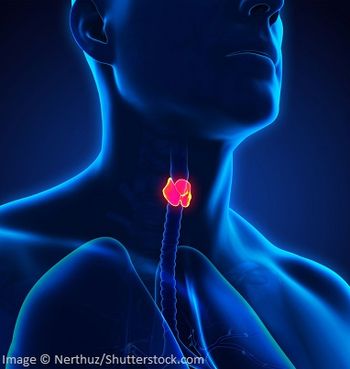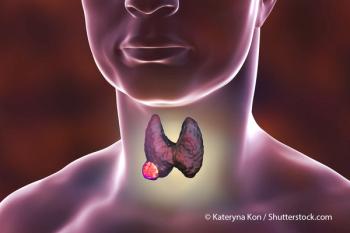
- ONCOLOGY Vol 11 No 12
- Volume 11
- Issue 12
SSO Thyroid Cancer Guidelines Questioned
As an endocrinologist who sees many patients with thyroid carcinoma and is active in postgraduate teaching, I must voice my reservations about some of the recommendations made in the Society of Surgical Oncology (SSO) practice guidelines
As an endocrinologist who sees many patients with thyroid carcinoma and is active in postgraduate teaching, I must voice my reservations about some of the recommendations made in the Society of Surgical Oncology (SSO) practice guidelines published in the August 1997 issue of oncology.
Treatment of Papillary Cancer, Benign Nodules
The guidelines mention that, in patients with papillary thyroid cancer, a lobectomy and isthmectomy are sufficient if the other lobe is grossly normal, and that a total thyroidectomy should be considered only in patients with a tumor that is bulky or involves both lobes. The guidelines also state that high-risk patients should be treated with radioiodine ablation, implying that low-risk patients should not receive this therapy.
It is typically impossible to adequately scan for small metastases in patients who have not received remnant ablation. Mazzaferri and Jhiang[1] analyzed the treatment of 1,355 patients with differentiated thyroid cancer over a 40-year period. They found that near-total thyroidectomy plus radioiodine therapy resulted in a distinct outcome advantage in patients with solitary tumors greater than 1.5 cm. I find it difficult to ignore their data. DeGroot[2] has echoed these findings.
The multicentric nature of papillary carcinoma must also be considered. If a patient has a tumor in one lobe, how can one be certain that foci do not exist in the other lobe, unless it is removed? I am not aware of any diagnostic studies that can exclude disease with complete efficiency.
The SSO guidelines recommend that patients with benign nodules be treated with levothyroxine therapy for 3 to 6 months. Although this has been a traditional mode of therapy, numerous recent articles[3-6] refute its effectiveness. One article[3] showed that significant regression occurred only with suppressive doses, which are well known to have adverse effects (eg, osteoporosis).
Use of Radionuclide Scans, Thyroglobulin Levels
The guidelines also recommend obtaining a radionuclide scan for lesions showing follicular cells on fine-needle aspiration (FNA) and observing whether the scan is hot. I feel that all follicular lesions should be removed, given the 10% to 15% chance of concurrent malignancy in a follicular adenoma[7]; although hot nodules are less likely to be malignant, I have seen several cases of thyroid cancer arising from hot follicular adenomas.[8] A scan cannot reliably distinguish benign from malignant lesions and should not be used for this purpose.
The guidelines recommend obtaining thyroglobulin levels for patients with papillary thyroid cancer. I maintain that this test is only of value in thyroidectomized patients who undergo radioiodine remnant ablation; the test would be of little utility in the low-risk patients for whom the guidelines recommend subtotal thyroidectomy, as these patients would still have considerable normal thyroid tissue present.
Finally, I am disturbed that the SSO has recommended these guidelines as a reference for health maintenance organization directors. I feel that many patients would receive inferior care if these guidelines were followed. I will still recommend aggressive therapy for my patients.
Matthew Neal, MD, FACPCo-Director of EndocrinologyBall Memorial HospitalMuncie, Indiana
The Thyroid Cancer Practice Guidelines Committee Responds
We would like to thank Dr. Neal for highlighting some of the controversial aspects of the management of thyroid cancer. These important issues have always been a subject of debate in national and international meetings. We do not think that there are right or wrong answers to these issues. Moreover, our article represents a few select guidelines and cannot completely encompass all aspects of thyroid cancer management, especially the controversial issues. In view of this, we would like to sincerely thank Dr. Neal for pointing out these controversial areas to the readers of oncology.
Our understanding of thyroid cancer has improved considerably in the last 2 decades with the detailed analysis of prognostic factors and risk groups in the management of thyroid cancer. Patients with thyroid cancer can be divided into low-, intermediate-, and high-risk groups. Even though the general consensus is that thyroid cancer is a good disease, it is definitely not a good disease in the high-risk patient with a high-risk tumor, in whom mortality is approximately 46%. In the low-risk group, on the other hand, mortality is less than 2%.
Management Approaches Depend on Risk Status, Prognostic Factors
The approaches used in the management of patients with thyroid cancer should depend mainly on the risk groups and prognostic factors, as well as the complications related to surgical treatment. One can virtually perform any operation for well-differentiated thyroid cancer, especially in the low-risk group, and find solid support for that procedure in the literature. Unfortunately, most reports in the literature are based on personal, emotional, and philosophical beliefs rather than any solid data. A randomized prospective trial is an impossibility in thyroid cancer due to its low mortality, especially in the low-risk group, and the prolonged course of follow-up.
Thyroid cancer has generated a considerable literature and provoked lively debate at meetings. It has clearly polarized two groups with strongly held beliefs based on personal philosophies and judgments: Those who favor total thyroidectomy with routine use of radioactive iodine and those who prefer less than total thyroidectomy. Even though we strongly subscribe to the use of total thyroidectomy followed by radioactive iodine ablation in high-risk patients, this approach needs to be reevaluated in low-risk patients in whom long-term mortality is very low. We ought to be certain that we are not overtreating patients and unnecessarily subjecting them to the risk of surgical complications.
References:
1. Mazzaferri EL, Jhiang SM: Long-term impact of initial surgical and medical therapy on papillary and follicular thyroid cancer. Am J Med 97:418-428, 1994.
2. DeGroot LJ: Long-term impact of initial surgical and medical therapy on papillary and follicular thyroid cancer (editorial). Am J Med 97:499, 1994.
3. Mereu P, Scala M, Schenone F, et al: Non-toxic nodular goiter: Treatment and follow-up. Acta Otorhinolaryngol Ital 15(4):301-304, 1995.
4. Giuffrida D, Gharib H: Controversies in the management of cold, hot, and occult thyroid nodules. Am J Med 99(6):642-650, 1995.
5. Cooper DS: Clinical review 66: Thyroxine suppression therapy for benign nodular disease. J Clin Endocrinol Metab 80(2):331-334, 1995.
6. Hurley DL, Gharib H: Evaluation and management of multinodular goiter. Otolaryngol Clin North Am 29(4):527-540, 1996.
7. Silverberg J, Gharib H: Evaluation and diagnosis of nodular thyroid disease, in Mazzaferri EL (ed): Endocrine Tumors, pp 233-240. Oxford, Blackwell Scientific Publications, 1994.
8. Neal JM: Woman with benign thyroid nodule, in Neal JM: Case Studies in Endocrinology, Diabetes. and Metabolism: A Problem-Oriented Approach, pp 69-71. New York, Igaku-Shoin, 1996.
Articles in this issue
about 28 years ago
Breast Cancer Treatment in Europeabout 28 years ago
New Endocrine Treatments for Prostate Cancerabout 28 years ago
FDA Grant Given to Continue Studies of Aminopterinabout 28 years ago
American Association for Cancer Research 1998 Research Fellowshipsabout 28 years ago
Breast Cancer: The Importance of Local Controlabout 28 years ago
Screening for Prostate Cancer-The European Viewabout 28 years ago
The Surgeon and Surgical Procedure as Prognostic FactorsNewsletter
Stay up to date on recent advances in the multidisciplinary approach to cancer.


















































































